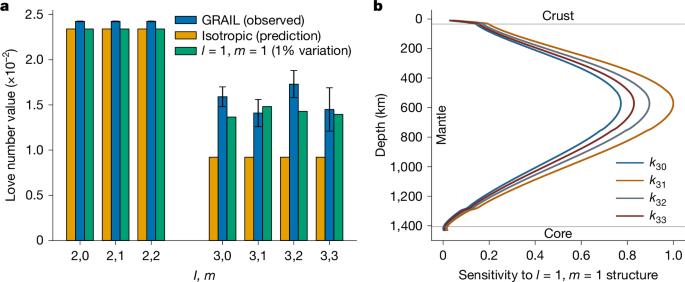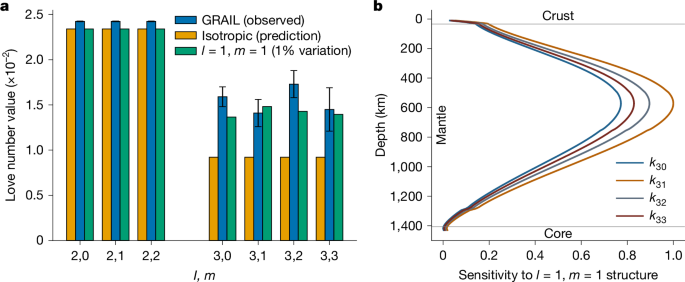从月潮响应推断月球地幔的热不对称性
IF 48.5
1区 综合性期刊
Q1 MULTIDISCIPLINARY SCIENCES
引用次数: 0
摘要
由于月球绕地球的偏心和倾斜轨道,它经历了周期性的潮汐强迫。对这种潮汐相互作用的响应驱动了月球重力场的时间变化,并且对卫星的内部结构很敏感。我们利用NASA GRAIL航天器5、6、7、8、9的数据恢复了随时间变化的月球重力场,包括3度引力潮汐Love数k3。在这里,我们报告了k3 = 0.0163±0.0007的估计值,这比球对称卫星的估计值高出约72%。如此大的k3可以用地幔的弹性剪切模量在近端和远端之间变化约2-3%来解释,这提供了月球深部内部横向非均质性的观测证明。这种不对称结构表明,在近地地幔中保存着大约100 - 200k的主要热异常,这种异常在30 - 40亿年前形成了表面海区11,并可能影响深月震的空间分布12。本文章由计算机程序翻译,如有差异,请以英文原文为准。


Thermal asymmetry in the Moon’s mantle inferred from monthly tidal response
The Moon undergoes periodic tidal forcing due to its eccentric and oblique orbit around the Earth1. The response to this tidal interaction drives temporal changes in the lunar gravity field and is sensitive to the satellite’s internal structure2–4. We use data from the NASA GRAIL spacecraft5–9 to recover the time-varying lunar gravity field, including a degree-3 gravitational tidal Love number, k3. Here, we report our estimated value of k3 = 0.0163 ± 0.0007, which is about 72% higher than that expected for a spherically symmetric moon10. Such a large k3 can be explained if the elastic shear modulus of the mantle varies by about 2–3% between the nearside and farside4, providing an observational demonstration of lateral heterogeneities in the deep lunar interior. This asymmetric structure suggests preservation of a predominantly thermal anomaly of roughly 100–200 K in the nearside mantle that formed surface mare regions 3–4 billion years ago11 and could influence the spatial distribution of deep moonquakes12. Data from the NASA GRAIL spacecraft recover the lunar gravity field suggesting preservation of a predominantly thermal anomaly in the nearside mantle, which could influence the spatial distribution of deep moonquakes.
求助全文
通过发布文献求助,成功后即可免费获取论文全文。
去求助
来源期刊

Nature
综合性期刊-综合性期刊
CiteScore
90.00
自引率
1.20%
发文量
3652
审稿时长
3 months
期刊介绍:
Nature is a prestigious international journal that publishes peer-reviewed research in various scientific and technological fields. The selection of articles is based on criteria such as originality, importance, interdisciplinary relevance, timeliness, accessibility, elegance, and surprising conclusions. In addition to showcasing significant scientific advances, Nature delivers rapid, authoritative, insightful news, and interpretation of current and upcoming trends impacting science, scientists, and the broader public. The journal serves a dual purpose: firstly, to promptly share noteworthy scientific advances and foster discussions among scientists, and secondly, to ensure the swift dissemination of scientific results globally, emphasizing their significance for knowledge, culture, and daily life.
 求助内容:
求助内容: 应助结果提醒方式:
应助结果提醒方式:


